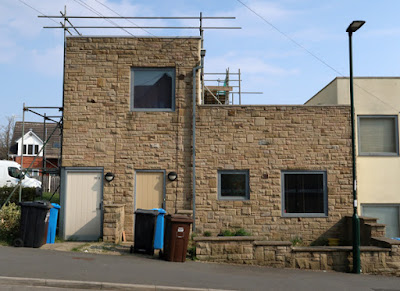Having had a quick wander around Birley Edge, to photograph its historic buildings for the British Listed Buildings website, I returned to the Greenmoor Rock escarpment and carried on down the public footpath to Back Edge.
Leaving the escarpment, I went to find The Orchard on Fox Hill Crescent and then stopped to look at the Birley Heights housing development, where I was very surprised to see that a high retaining wall had been been built with gabions, whose strength and stability are dependent on the durability of the wire used to make them.
Continuing down Fox Hill Crescent, I stopped briefly to look at a small development of one and two storied modern apartments, which are partly faced not with brick – as would probably have been expected – but with an Upper Carboniferous sandstone of unknown provenance.
At Fox Hill Road, I firstly photographed the Grade II Listed sewer gas lamp, very many of which are still preserved in Sheffield, before heading down the hill towards Wadsley Bridge. The suburb of Birley Carr contains a core of late Victorian terraced houses, which are presumably built with the local Grenoside Sandstone, with the former Mount Zion Methodist Chapel (1877) being the most substantial stone building that I saw.
The masonry is very blackened in places, but there is enough fresh surfaces of sandstone exposed to reveal that it is cross-bedded and uniformly yellow in colour, which is characteristic of the Grenoside Sandstone that I had seen earlier in my walk at Grenoside.
Further down Fox Hill Road, there are more later Victorian terraced houses, where the masonry is also very blackened and, continuing down Parson Cross Road, I photographed a couple of recently cleaned houses. One of these is built with yellow sandstone, but the stone in the other house is much paler in colour, which from a distance looks more like the Crawshaw Sandstone.
Reaching Halifax Road, I turned left and headed up to the Grade II Listed Hannah Rawson School (1829), now the Parsons Cross Church of England Primary School, where I asked permission to photograph its exterior.
I only took a few general record photos of the building, without studying the stonework closely, but when zooming into the plaque that records the endowment by Hannah Rawson, I could see that its uniform yellow colour and cross-bedding indicates another example of the Grenoside Sandstone.
After having a quick look at the exposure of the Greenmoor Rock at Kilner Way Retail Park, which I shall describe later, I set off down the Halifax Road towards Hillsborough and stopped to photograph the Wadsley Bridge war memorial, which is made with Cornish granite in the form of a wheel cross and is surprisingly not a listed structure.
Behind the war memorial is the former Centenary Chapel (1839), which has been fairly recently cleaned to reveal a very coarse grained gritstone, with grey to orange colour variation, which is probably Chatsworth Grit from the Rivelin Valley.











No comments:
Post a Comment